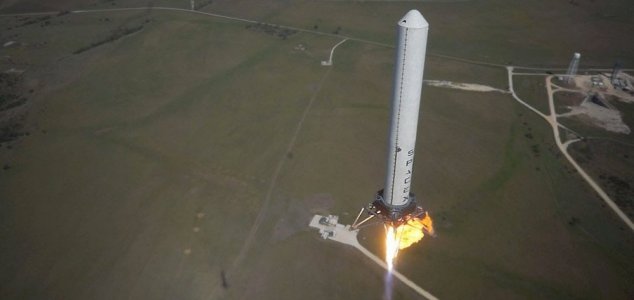Space & Astronomy
October 14, 2013 · 14 comments
14 comments

The rocket is able to initiate a controlled descent back to the ground. Image Credit: SpaceX / YouTube
In an impressive demonstration flight this week, the rocket took off from SpaceX's test pad in McGregor, Texas and flew to a height of half a mile before returning to the ground in a controlled descent that saw it land on the exact spot from which it had launched.
While conventional first-stage rockets are simply jettisoned and can only be used once, the Grasshopper has the potential to provide a long-term reusable solution that could change the way we put things in to space.
An impressive video of the test flight taken from a remote-controlled hexacopter hovering nearby has been released online and can be viewed below.
Source: YouTube | Comments (14)
SpaceX Grasshopper test flight successful
By T.K. RandallOctober 14, 2013 ·
 14 comments
14 comments
The rocket is able to initiate a controlled descent back to the ground. Image Credit: SpaceX / YouTube
A remarkable new type of reusable rocket could soon revolutionize how we launch things in to space.
SpaceX's Grasshopper rocket might at first glance appear to be like any other, but what it lacks in visual uniqueness it makes up for in innovation. Unlike conventional chemical rockets, the Grasshopper will be able to launch, deliver its payload and then land again in a vertical position.In an impressive demonstration flight this week, the rocket took off from SpaceX's test pad in McGregor, Texas and flew to a height of half a mile before returning to the ground in a controlled descent that saw it land on the exact spot from which it had launched.
An impressive video of the test flight taken from a remote-controlled hexacopter hovering nearby has been released online and can be viewed below.
Source: YouTube | Comments (14)

The Unexplained Mysteries
Book of Weird News
AVAILABLE NOW
Take a walk on the weird side with this compilation of some of the weirdest stories ever to grace the pages of a newspaper.
Click here to learn more

Support us on Patreon
BONUS CONTENTFor less than the cost of a cup of coffee, you can gain access to a wide range of exclusive perks including our popular 'Lost Ghost Stories' series.
Click here to learn more
United States and the Americas
Space: Astronomy and Astrophysics
Ancient Mysteries and Alternative History
Israel, Palestine and the Middle-East
Total Posts: 7,604,109 Topics: 316,268 Members: 201,816
Not a member yet ? Click here to join - registration is free and only takes a moment!
Not a member yet ? Click here to join - registration is free and only takes a moment!





























Please Login or Register to post a comment.